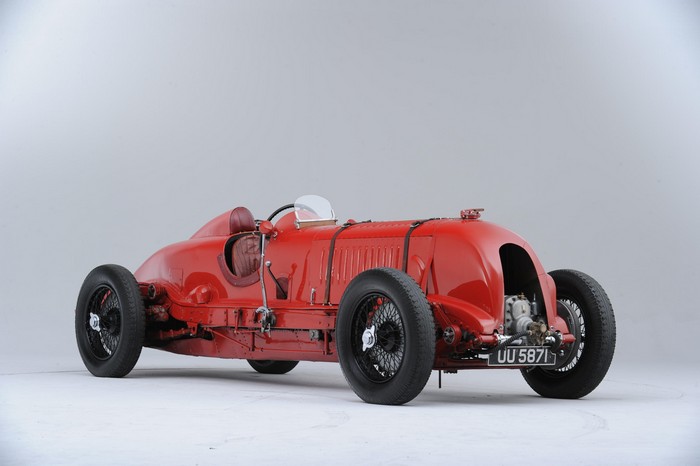Chassis Number: HB3402
Among all Brooklands habitués of the 1920–30s, perhaps the most glamorous and charismatic of all the historic motor course’s racing celebrities was the diminutive Bentley-driving Baronet, Sir Henry Ralph Stanley “Tim” Birkin. He combined his “Bentley Boy” high-society image with a fearless driving talent.
With fellow enthusiast/racer Mike Couper, Birkin & Couper Ltd was established at Welwyn, where it produced the prototype 4½ Litre “Blower” Bentley in the summer of 1929. W.O. Bentley recalled: “They would lack in their preparation all the experience we had built up in (our own) racing department over 10 years. I feared the worst and looked forward to their first appearance with anxiety….”
Birkin ran his prototype tourer-bodied car in the Brooklands 6-Hour race on June 29, 1929. The car retired. In the RAC Tourist Trophy at Ards in Ulster, Bernard Rubin’s “Blower” overturned while Birkin, who had challenged W.O. to act as his riding mechanic (the marque’s founder accepting), placed a worthy second overall and won his class.
W.O. summed it up as follows: “The supercharged 4½ never won a race, suffered a never-ending series of mechanical failures, brought the marque Bentley disrepute and incidentally cost Dorothy Paget a large sum before she decided to withdraw her support in October 1930…”
The assertion that the “Blower” Bentley never won a race is wrong. The car offered here is the exception.
At the Birkin & Couper Ltd Works in Welwyn, this special track-racing “Blower” Bentley was developed. In its 1930 form, with Villiers’ supercharger driven from the crankshaft nose and inhaling through two huge horizontal SU carburetors, the car’s engine developed some 240 horsepower on alcohol fuel mix, some 65 horsepower more than a standard “Blower” Bentley on petrol.
The first Brooklands Meeting of 1930 saw Birkin taking second place in the three-lap Kent Short Handicap race. His flying lap was clocked at 123.89 mph. He then contested the meeting’s Surrey Short Handicap, setting fastest lap at 124.51 mph.
In the four-lap Kent Long Handicap, Birkin then won by one second at a 119.13 mph average, and setting fastest lap at 126.73 mph. This was the first race victory ever achieved by a “Blower” Bentley.
Brooklands’ Easter meeting then saw Birkin campaign his single-seater before a crowd of 20,000, easily winning the Bedford Short Handicap at 117.81 mph.
In the BRDC 500 Miles on October 4, 1930, a front tire burst at top speed during practice, which both car and driver survived despite “some astonishing subsequent gyrations.”
Dorothy Paget withdrew her backing from the “Blower” Bentley endurance racing team but retained the successful single-seater. The BARC Whitsun Meeting in 1931 saw the great car’s return to Brooklands, but again Birkin’s best efforts with it were overshadowed, as it lapped at a best of 128.69 mph in the Gold Star Handicap, then 131.06 mph in the Somerset Senior Long before retiring.
For 1932, the single-seater was resprayed red in place of its original blue, and its engine was re-bored to 100.5 mm, providing a capacity of 4,442 cc. The new season opened on Easter Monday, but four days prior to that meeting, Birkin attacked the Kay Don Outer Circuit lap record and broke it at last — raising the mark to 137.96 mph.
Birkin died in 1933 at the age of 36 after contracting septicemia from burning his arm on the exhaust while racing a Maserati in Italy. Dorothy Paget retained the single-seater until 1939, resisting all offers from would-be buyers until Bentley enthusiast Peter Robertson-Rodger blew up the engine of his ex-Birkin French GP “Blower” at Donington Park, and he charmed her into selling him the track car, so he could use its engine in the sister Birkin car.
Then came World War II. The number one “Blower” engine was then returned to the single-seater, which Robertson-Rodger decided to convert into a two-seat roadster.
The project was finally completed in the late 1940s using a two-seat body designed by Robertson-Rodger and made by Chalmers of Redhill. Bentley specialist and VSCC luminary John Morley subsequently worked on the great car, and when Peter Robertson-Rodger died in 1958, he bequeathed the single-seater in his will to Morley.
Meanwhile, boyhood Birkin fan and Bentley enthusiast “Rusty” Russ-Turner heard the car was for sale and bought it, with the single-seat body included in the deal.
After Russ-Turner’s death, George Daniels was lucky enough to acquire it, and it is now offered here as a machine with a unique place in racing history. The Bentley comes with road equipment including wings, an extensive history file including correspondence, road-registration documents and large-format photo album.

